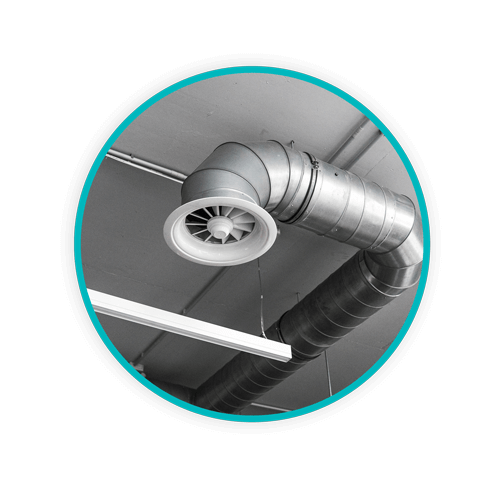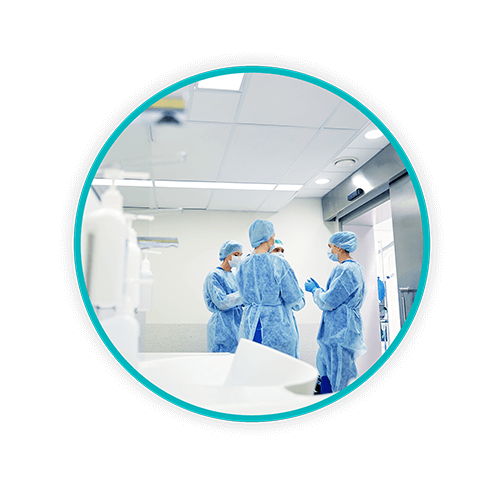Is Your Facility Prepared for the Next Pandemic?

The next pandemic will be __________. Notice I left a blank there. If I knew that answer, I would be famous. However, as a certified Infection Preventionist (IP) I can speak from experience, both current and from the COVID-19 pandemic.
Infection Preventionists ensure that healthcare workers and patients do everything they should to prevent infections. While a lot has changed since the onset of COVID-19, there are many “lessons learned” from the pandemic that should be put into place today.
Healthcare facilities should start planning before the next pandemic is in sight. They should act now to implement infection prevention best practices if they haven’t already. So, what does that look like? Here are some top lessons learned from the COVID-19 pandemic as well as recommendations on actions that facilities can take.
TOPICS WE WILL COVER:
1 / Enhancing the Wellbeing of Healthcare Professionals
2 / Securing a Supply Chain to Avoid Limited Resources
3 / Enhancing Communication to Instill Trust
5 / Training Managers in Mental Health Awareness
6 / Staying Ahead of the Next Pandemic
Enhancing the Wellbeing of Healthcare Professionals
 Healthcare professionals identified their patients as the most significant at risk during the COVID-19 pandemic. Nevertheless, it was later discovered that all people were at significant risk.
Healthcare professionals identified their patients as the most significant at risk during the COVID-19 pandemic. Nevertheless, it was later discovered that all people were at significant risk.
When hospitals began to reach capacity, healthcare professionals experienced shared feelings of information overload, fear, and lack of support. Inevitably, the number of available healthcare professionals dropped. Some of this was due to illness. It was known as one of the most dangerous jobs in 2020. Healthcare professionals were in a danger zone, and no place was safe.
Patient and healthcare worker safety is not a separate priority, but central to safe, effective healthcare systems. Healthcare leaders need to enhance their position on safety in the workplace. COVID-19 was everywhere for workers, not just where they worked.
Workplaces should protect and promote health to create a safe culture. Workers may have comorbidities that make them more susceptible and suffer more severe consequences from infection. Keeping current on guidance recommendations by reputable authorities is paramount to worker safety. Looking at Total Work Health (TWH) has shown “classic social issues that workers face, like childcare, sick leave, and disability issues [has] underlined safety concerns in healthcare environments where professionals need to treat patients” (Igoe, 2021). It is critical to understand the entire work environment and its personal and professional pressure points, not just duties on the job.
Securing a Supply Chain to Avoid Limited Resources
 The vulnerabilities in medical product supply chains were recognized during the COVID-19 pandemic, partly because the demand for items was so high. In addition, the materials required to make more supplies were also limited. Supplies of personal protective equipment (PPE) for healthcare workers were limited, heightening risks of healthcare workers becoming infected with SARS-CoV-2 or any other pathogen.
The vulnerabilities in medical product supply chains were recognized during the COVID-19 pandemic, partly because the demand for items was so high. In addition, the materials required to make more supplies were also limited. Supplies of personal protective equipment (PPE) for healthcare workers were limited, heightening risks of healthcare workers becoming infected with SARS-CoV-2 or any other pathogen.
Most healthcare facilities have a few vendors they work with to get their par level of supplies. It was evident during the pandemic that diversifying vendors is beneficial. Reaching across the medical supply chain to find vendors that can fill the gaps is essential.
Not being able to secure necessary supplies led to unorthodox purchasing from overseas countries where medical supplies aren’t typically imported. The FDA suggests “preventing or mitigating shortages with strategies such as shelf-life extensions, [and] expedited review of manufacturing supplements” (Califf et al., 2023).
Even after the COVID-19 pandemic was nearing its peak, PPE supplies were still lacking. In July 2022, Monkeypox (MPX) was designated as a Public Health Emergency of International Concern (PHEIC). It was noted that resources were still suffering from the COVID-19 pandemic. It is vital to determine the readiness of these types of resources for future pandemics (Umar et al., 2022).
In addition, there were shortages of ventilators and intensive care beds. This led healthcare workers and hospital leadership to make ethical and moral decisions without prior preparation. Decision-making tools need to be developed to ensure that no person receives better or worse treatment due to his or her social status.
Enhancing Communication to Instill Trust
If Ebola did not teach us how important communication was, then the COVID-19 pandemic should have. The misinformation was rampant. Individuals were performing their own research and believing misguided information not rooted in science.
The slogan “no one is safe until everybody is safe” is not mere rhetoric but an epidemiological reality (Sachs et al., 2022). Early, constant, and transparent communication with staff is vital to instilling trust. Healthcare facilities should communicate daily with staff about infection prevention and control guidelines and any updates that will be occurring.
A variety of communication streams is an excellent way to capture the attention of more staff. Email blasts are a good way to keep things short and give the required information. One IP stated, “Staff forwarded these blast emails to family and friends. A wonderful byproduct occurred: our staff became the source of correct COVID-19 information” (Grant, 2021). Healthcare facilities can now start planning how to disseminate information to staff and patients in advance.
Improving Air Quality
 Hospitals must have minimum air changes in patient rooms, with more frequent air changes in other select areas. As more COVID-19 patients were entering healthcare facilities, this led to a concern about air quality, especially since SARS-CoV2 is suspected to be transmitted to others by airborne transmission. While it was not possible to completely redo air handlers in all healthcare facilities, other tools, like UV lights and high-efficiency particulate air filters, were used to complement air quality.
Hospitals must have minimum air changes in patient rooms, with more frequent air changes in other select areas. As more COVID-19 patients were entering healthcare facilities, this led to a concern about air quality, especially since SARS-CoV2 is suspected to be transmitted to others by airborne transmission. While it was not possible to completely redo air handlers in all healthcare facilities, other tools, like UV lights and high-efficiency particulate air filters, were used to complement air quality.
Changing how symptomatic patients navigated through the healthcare facility was another way to keep transmission to a minimum. Locations were designated for the care of patients with known or suspected COVID-19. This was an alternate entrance, unit, or area. Social distancing and masking also assisted with decreasing possible transmission.
Early on, the CDC stated that COVID-19 was likely transmitted by contact and droplets. Currently, the CDC lists an N95 or higher respirator as the preferred respiratory protection. Early interventions into air quality could have decreased the high number of infections seen. Healthcare facilities can now outfit their air handling systems to prepare for the next airborne pathogen that could lead to a pandemic. Sachs et al. stated, “A failure was…costly delays in acknowledging the crucial airborne exposure pathway of SARS-CoV-2, the virus that causes COVID-19, and in implementing appropriate measures at national and global levels to slow the spread of the virus.”
Training Managers in Mental Health Awareness
During the COVID-19 pandemic, healthcare workers made themselves vulnerable. They did this out of compassion and duty, and it took a heavy toll that did not end when the pandemic ended. This led to healthcare worker burnout, lack of support, and misplaced emotions.
NYC Health + Hospitals, the most extensive municipal hospital system in the US, stepped up and “provided stress management and resilience training, recharge rooms, peer support champions (wellness) rounds, and easy-to-access mental health resources” (Wei et al., 2021). These were so well received that they are still in place today. One recognized issue in healthcare workers during the COVID-19 pandemic was chronic exposure to stressful working conditions, including the exclusion from decision-making. This and other stresses led to healthcare worker turnover.
The CDC cited that healthcare workers reported a significant increase in poor mental health days in the previous 30 days from 2018 (3.3 days) to (4.5 days). Overall, 45.6% of healthcare workers reported feeling burnout often or very often in 2022.
Healthcare leadership must recognize that the toll healthcare workers suffered during the COVID-19 pandemic is still felt today. Training managers in mental health awareness and ways to support workers and improve safety culture can help. Engaging staff in decision-making and reducing workloads will increase work satisfaction.
Staying Ahead of the Next Pandemic
We don’t yet know what the next pandemic will be or when it will occur. But with the proper protocols, practices, and procedures in place, hospital facilities can be prepared to face the unknown. The COVID-19 pandemic taught us that we can adapt to new realities with appropriate preparedness, clear communication, decisive action, and an emphasis of physical and mental wellbeing. As an infection preventionist, I am confident that with these best practices, hospital can stay prepared for the next pandemic.
-
Califf, R.M., Marston, H. (2023).Lessons learned from COVID-19 are informing preparation for future public health emergencies. US Food & Drug Administration. https://www.fda.gov/news-events/fda-voices/lessons-learned-covid-19-are-informing-preparation-future-public-health-emergencies
-
Nigam JA, Barker RM, Cunningham TR, Swanson NG, Chosewood LC.Vital Signs: Health Worker-Perceived Working Conditions and Symptoms of Poor Mental Health – Quality of Worklife Survey, United States, 2018-2022.MMWR Morb Mortal Wkly Rep 2023;72:1197-1205.DOI: https://dx.doi.org/10.15585/mmwr.mm7244e1
-
Grant, P. (2021).Returning to the new normal: Lessons learned during a COVID-19 reality journey.Prevention Strategist, 14(2), 49–50.
-
Igoe, K.(2021).How COVID-19 has changed the standards of worker safety and health – and how organizations can adapt. Harvard T.H. Chan School of Public Health. https://www.hsph.harvard.edu/ecpe/how-covid-19-changed-worker-safety-and-health/
-
Sachs, J. D. (2022).The Lancet Commission on lessons for the future from the COVID-19 pandemic. Lancet, 400(Oct 2022), 1224-80. https://doi.org/10.1016
-
Umar TP, Kadir AKMS, Mohammed YA, Setti MO. Healthcare system preparedness for the next pandemic beyond COVID-19 situation. J Prev Med Hyg 2022;63:E493-E494. https://doi.org/10.15167/2421-4248/jpmh2022.63.4.2786
-
Wei, E.K., Long, T., & Katz, M.H. (2021). Nine lessons learned from the COVID-19 pandemic for improving hospital care and healthcare delivery. JAMA Internal Medicine, 181(9), 1161. https://doi.org/10.1001/jamainternmed.2021.4237
Let's Talk!
Your time is valuable, and we don’t want to play hard to get. You can either phone us directly on the details listed on our contact page, or feel free to fill out this short form and one of our team members will get back to you as quickly as possible.
